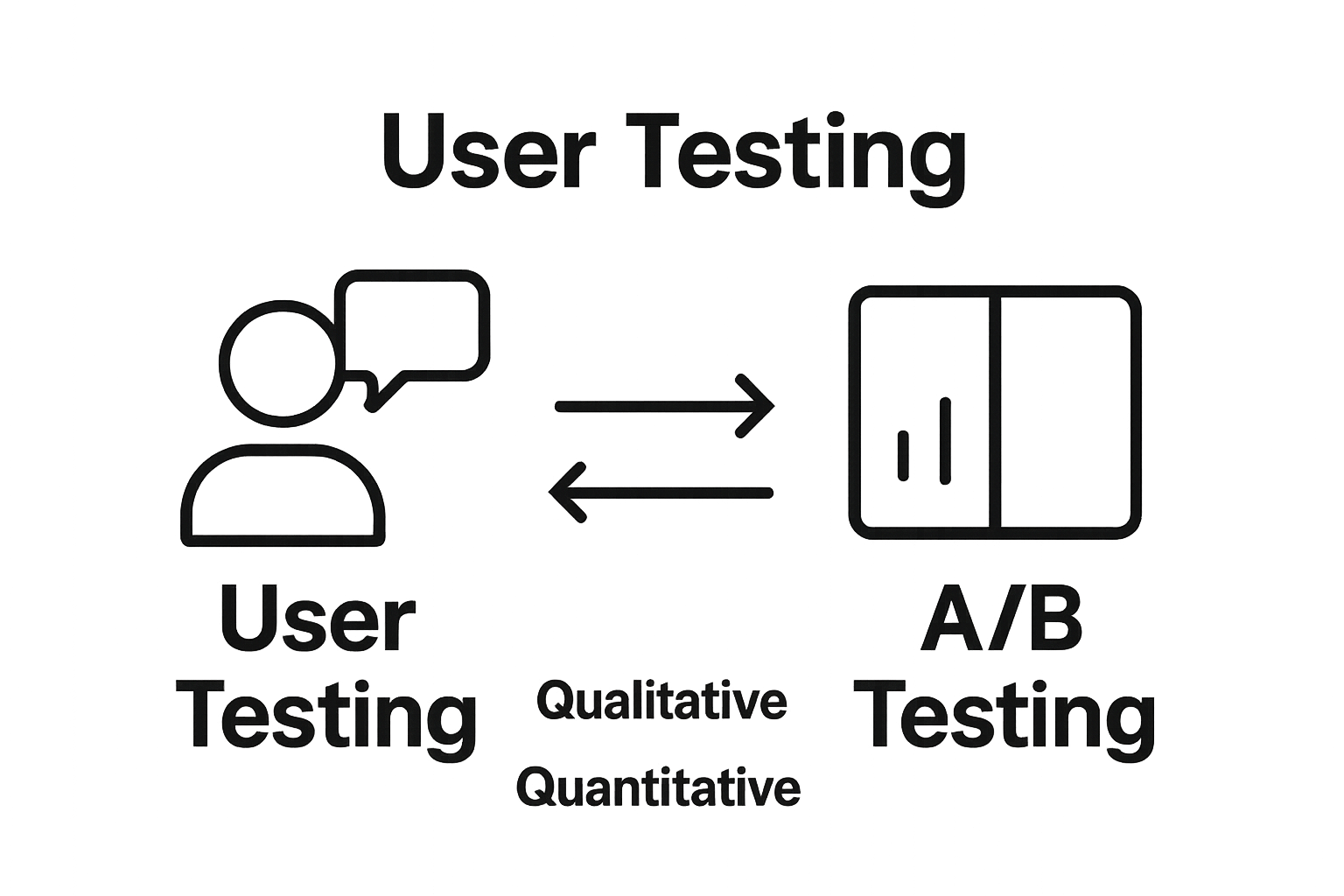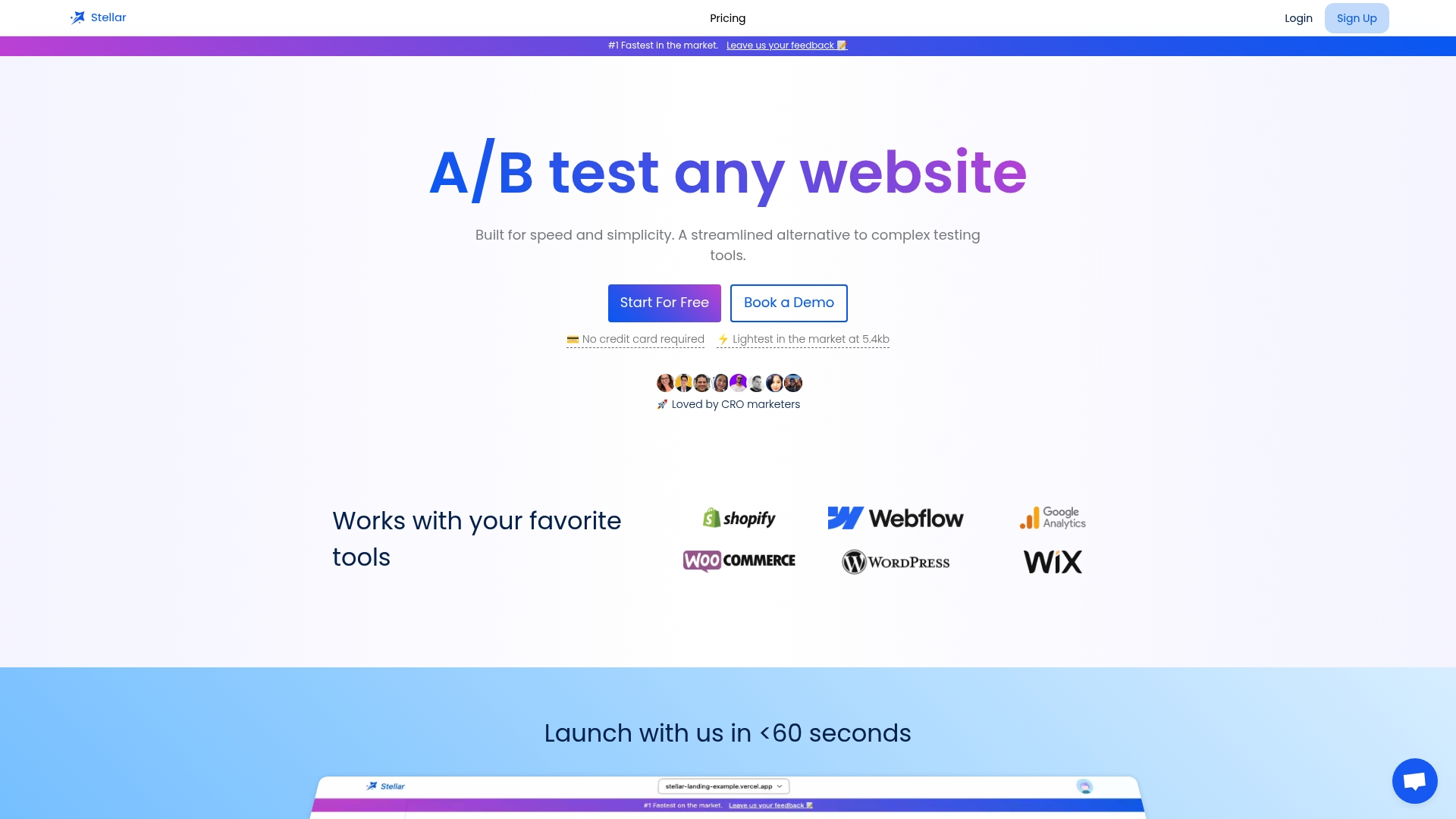
User Testing vs A/B Testing: Understanding the Differences

User testing and A/B testing power some of the world's most successful digital products, yet most people lump them together as the same thing. Picture this. Companies that use systematic testing are 2.5 times more likely to exceed their business goals. That’s not just impressive, it’s transformative. But the real surprise is how completely different these two methods are in their impact and the kind of insights they deliver. Knowing when to use each one can be the difference between just keeping up and absolutely leading the market.
Table of Contents
- Defining User Testing And A/B Testing
- The Importance Of User Testing And A/B Testing
- How User Testing And A/B Testing Work
- Key Concepts In User Testing Versus A/B Testing
- Real-World Applications Of User Testing And A/B Testing
Quick Summary
| Takeaway | Explanation |
|---|---|
| User testing reveals qualitative insights. | This method helps identify user experiences and emotional responses, providing depth that numbers alone cannot convey. |
| A/B testing delivers quantitative performance data. | By comparing design variations, A/B testing determines which elements drive better user engagement and conversion rates. |
| Integrate both methods for optimal results. | Combining qualitative insights from user testing with quantitative data from A/B testing enhances product development strategies. |
| User testing minimizes usability issues early. | Identifying potential pain points during development reduces costs and improves overall user satisfaction. |
| A/B testing allows for data-driven decisions. | Companies that use systematic A/B testing significantly increase their likelihood of meeting business goals through informed design choices. |
Defining User Testing and A/B Testing
In the realm of digital product development and marketing optimization, two critical research methodologies stand out: user testing and A/B testing. While they might seem similar at first glance, these approaches serve distinct purposes in understanding user behavior and improving digital experiences.
Understanding User Testing
User testing is a comprehensive research method focused on evaluating how real users interact with a product or service. Unlike quantitative approaches, user testing offers qualitative insights into user experiences, behaviors, and potential pain points. During a typical user testing session, participants are observed performing specific tasks while researchers collect detailed feedback about their interactions, emotions, and challenges.
Key characteristics of user testing include:
- Direct observation of user interactions
- Gathering qualitative, in-depth insights
- Understanding user behavior and emotional responses
- Identifying usability issues and potential improvements
A/B Testing: A Data-Driven Approach
A/B testing, alternatively known as split testing, represents a quantitative method of comparing two different versions of a digital element to determine which performs better. By presenting variant A and variant B to different user segments, researchers can statistically analyze which version yields superior results in terms of specific metrics like conversion rates, click-through rates, or engagement levels.
Critical aspects of A/B testing include:
- Controlled experimental design
- Statistically significant sample sizes
- Precise measurement of specific performance indicators
- Objective comparison between design variations
While both methodologies aim to enhance user experience, they differ fundamentally in approach and output. User testing provides rich, contextual understanding of user interactions, whereas A/B testing delivers precise, quantifiable performance data.
To help clarify the distinctions between user testing and A/B testing, the table below compares their core characteristics and approaches.
| Aspect | User Testing | A/B Testing |
|---|---|---|
| Data Type | Qualitative (in-depth insights) | Quantitative (statistical data) |
| Main Purpose | Understand user behavior and experience | Compare performance of variations |
| Methodology | Direct observation and feedback | Controlled, randomized experiments |
| Typical Output | Usability issues, user pain points, emotional responses | Metrics like conversion rate, engagement, click-through rate |
| Sample Size | Small, focused user groups | Large, statistically significant samples |
| Application | Early-stage design, uncovering usability challenges | Optimization of specific elements, data-driven decision making |
| Insight Depth | Rich, contextual, and narrative | Precise, measurable, and comparative |
| Learn more about data-driven insights in our comprehensive A/B testing guide. |
The Importance of User Testing and A/B Testing
Understanding the strategic value of user testing and A/B testing can transform how businesses approach digital product development and marketing optimization. These methodologies are not just research techniques but powerful tools for driving meaningful improvements and making data-informed decisions.
Strategic Business Impact
Both user testing and A/B testing serve critical roles in helping organizations minimize risks and maximize user satisfaction. User testing provides deep qualitative insights into user experience, revealing nuanced behavioral patterns and emotional responses that quantitative data might miss. Conversely, A/B testing delivers precise, measurable performance metrics that directly correlate with business objectives.
Key strategic benefits include:
- Reducing development costs by identifying issues early
- Minimizing user friction and improving overall experience
- Validating design decisions with empirical evidence
- Enabling continuous product improvement
Decision Making and Risk Mitigation
Research from leading UX organizations indicates that companies leveraging systematic testing methodologies are 2.5 times more likely to exceed their business goals. By implementing rigorous testing frameworks, businesses can make informed decisions that are grounded in actual user behavior rather than assumptions.
A/B testing, in particular, allows for controlled experimentation where small variations can reveal significant insights about user preferences. This approach transforms potentially risky design changes into calculated, measurable adjustments that can dramatically improve conversion rates and user engagement.
Long-Term Business Optimization
The true power of these testing methodologies lies in their ability to foster a culture of continuous improvement. Explore our comprehensive guide on onboarding A/B test campaigns to understand how systematic testing can become a core part of your product development strategy. By consistently gathering and analyzing user feedback and performance data, organizations can create more intuitive, user-centered digital experiences that adapt and evolve with changing user needs.
How User Testing and A/B Testing Work
The practical implementation of user testing and A/B testing involves distinct methodological approaches that help organizations gain valuable insights into user behavior and product performance. Understanding their operational frameworks reveals how these techniques transform raw data into actionable intelligence.
User Testing Methodology
User testing operates through direct, controlled observation of participants interacting with a product or service. Researchers carefully design scenarios that simulate real world interactions, enabling them to capture authentic user experiences. During these sessions, participants are typically asked to complete specific tasks while researchers meticulously document their behaviors, emotional responses, and potential challenges.
Key operational characteristics include:
- Recruiting representative user segments
- Creating realistic task scenarios
- Recording user interactions and verbal feedback
- Analyzing qualitative performance indicators
A/B Testing Experimental Design
A/B testing follows a more structured, quantitative experimental approach. Researchers develop two distinct variants of a digital element and randomly distribute them among user groups. By tracking specific performance metrics, they can statistically determine which version produces superior outcomes.
Critical experimental parameters include:
- Defining clear, measurable performance objectives
- Establishing statistically significant sample sizes
- Randomly allocating users to variant groups
- Implementing precise tracking mechanisms
Data Analysis and Interpretation
Both methodologies ultimately aim to transform raw data into meaningful insights. User testing generates rich contextual understanding through qualitative analysis, while A/B testing provides precise, numerically validated performance comparisons. Learn more about interpreting testing results in our comprehensive onboarding guide to understand how these techniques can drive strategic decision making.
The synergy between these approaches allows organizations to develop a holistic understanding of user interactions, combining deep behavioral insights with quantitative performance metrics.
Key Concepts in User Testing versus A/B Testing
While user testing and A/B testing are both critical research methodologies, they differ significantly in their fundamental approaches, objectives, and analytical frameworks. Understanding these nuanced distinctions helps organizations select the most appropriate method for their specific research and optimization goals.

Research Objectives and Data Collection
User testing focuses on comprehensive user experience understanding, gathering rich qualitative data about how individuals interact with a product. Researchers aim to uncover deep insights into user behaviors, emotional responses, and potential usability challenges. In contrast, A/B testing centers on quantitative performance measurement, comparing specific design variations to determine statistically significant improvements.
Key research objective differences include:
The following table summarizes the primary research objectives and data collection strategies for user testing versus A/B testing, providing a quick reference to guide method selection.
| Dimension | User Testing | A/B Testing |
|---|---|---|
| Research Focus | Comprehensive user experience and behavior | Performance of specific design variations |
| Data Collected | Observational notes, user feedback, emotions | Conversion rates, clicks, quantitative metrics |
| Approach | Exploratory, holistic | Confirmatory, targeted |
| Key Outcome | Usability insights, pain points | Statistical performance comparison |
- Depth of user understanding versus precise performance metrics
- Exploratory versus confirmatory research approaches
- Holistic experience mapping versus targeted optimization
- Narrative insights versus numerical validation
Analytical Methodologies
The analytical approaches in user testing and A/B testing represent fundamentally different research paradigms. User testing employs observational and interpretive research techniques that prioritize understanding complex user interactions, while A/B testing utilizes controlled experimental designs with strict statistical protocols.
Critical analytical distinctions include:
- Qualitative interpretation versus statistical significance
- Small sample, in-depth analysis versus large sample quantitative assessment
- Contextual understanding versus numerical performance tracking
- Exploratory insights versus definitive comparative results
Practical Application and Decision Making
Both methodologies contribute unique value to product development strategies. User testing provides nuanced insights that help designers empathize with user experiences, while A/B testing offers precise, data-driven optimization recommendations. Explore our comprehensive guide on understanding testing variations to develop a more sophisticated approach to research methodologies.
Ultimately, the most effective product development strategies integrate both approaches, leveraging qualitative user testing insights to inform quantitative A/B testing experiments.
Real-World Applications of User Testing and A/B Testing
In the dynamic landscape of digital product development, user testing and A/B testing have emerged as critical tools for organizations seeking to optimize user experiences and drive strategic decision making. These methodologies provide actionable insights across diverse industries, transforming how businesses understand and engage with their target audiences.
Digital Product and Website Optimization
Digital platforms leverage these testing methodologies to enhance user interactions and improve conversion rates. E-commerce websites, for instance, utilize A/B testing to experiment with different design elements, such as button colors, placement of call-to-action sections, and checkout processes. By systematically comparing user responses to these variations, companies can make data driven improvements that directly impact revenue and user satisfaction.
Key application areas include:
- Refining website navigation structures
- Optimizing landing page designs
- Improving conversion funnel performance
- Reducing user drop-off rates
User Experience in Software and Mobile Applications
Software developers and mobile application designers rely extensively on user testing to uncover nuanced interaction challenges. Researchers conduct comprehensive usability studies that reveal how users navigate interfaces, identify potential friction points, and understand complex user journeys. These insights enable developers to create more intuitive, user-friendly digital experiences.
Critical application domains encompass:
- Identifying unintuitive interface elements
- Understanding user navigation patterns
- Detecting potential user frustration points
- Validating design hypotheses before full implementation
Marketing and Customer Engagement Strategies
Marketing teams increasingly employ A/B testing to refine communication strategies and improve customer engagement. Learn more about integrating user feedback with testing methodologies to develop more sophisticated marketing approaches. Email campaigns, advertisement designs, and digital marketing content can be systematically tested to determine which variations generate superior audience responses.
By integrating user testing and A/B testing, organizations transform raw data into strategic insights, enabling more responsive, user-centric product development across multiple domains.

Transform User Insights into Real Results with Stellar
Feeling stuck between in-depth user testing and actionable A/B testing? Many businesses struggle to turn rich user feedback and behavioral insights into fast, measurable improvements. As the article explains, balancing qualitative understanding from user testing with the hard data of A/B testing can be overwhelming, especially when technical barriers slow down your progress or when traditional tools are overly complex.
Stellar provides the missing link—combining rapid experimentation with qualitative learning. Our A/B Testing Tool is built for marketers and product teams who want to make confident decisions without writing code. You get a lightweight platform, a no-code visual editor, and real-time analytics so you can focus on finding what works, not figuring out complicated software. Test messaging, page layouts, and user journeys—all while maintaining site speed and smooth experiences discussed in the article.

Stop letting insights collect dust. Join the businesses already streamlining optimization with Stellar. See how easy it is to bridge qualitative research with powerful A/B testing. Start today on https://gostellar.app and unlock the benefits of fast, evidence-based growth for your organization.
Frequently Asked Questions
What is user testing?
User testing is a research method that evaluates how real users interact with a product or service, providing qualitative insights into user experiences, behaviors, and pain points through direct observation.
How does A/B testing differ from user testing?
A/B testing is a quantitative method that compares two versions of a digital element to determine which performs better based on specific metrics, while user testing focuses on gathering qualitative user experiences and identifying usability issues.
Why are both user testing and A/B testing important?
Both methodologies minimize risks, enhance user satisfaction, and facilitate data-informed decisions in product development and marketing optimization, ultimately leading to better user experiences and improved business outcomes.
How can I implement user testing and A/B testing in my organization?
To implement user testing, recruit representative users and observe them interacting with your product. For A/B testing, develop different versions of a digital element, randomly assign users to each version, and measure performance metrics to identify which option yields better results.
Recommended
Published: 9/15/2025